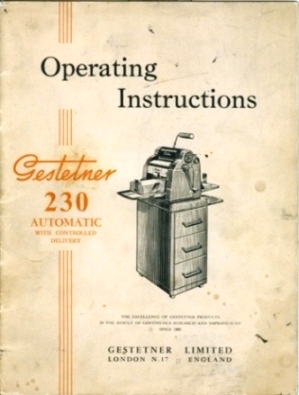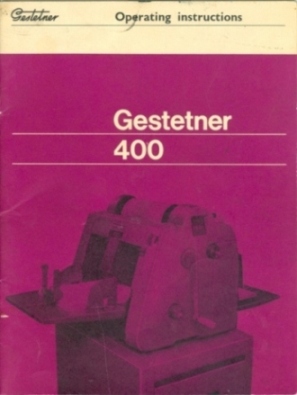|
Once upon a time, duplicators (aka mimeographs) were a standard piece of office equipment. They came with instruction manuals such as those from my collection below that instructed you in their operation and explained the purpose of every knob and lever, as you would expect.
What they didn't instruct you in was how to use a typewriter to cut a stencil because this was something everyone knew, or at least older hands in your office did and they could show you how. However, time marches on, both typewriters and duplicators are now obsolete technology, and what was once common knowledge is now distinctly uncommon. In recent years, three decades after this technology was consigned to the scrap heap, younger people have started taking an interest in it. It's not too hard to find old duplicators on eBay and the like, but locating supplies of their 'consumables' - ink, paper, stencils - is only going to get more difficult. You can find substitutes for the ink and paper that, while not perfect, are acceptable but there's no substitute for 'wax' stencils (so called to differentiate them from the 'carbon' stencils used by electrostencil machines - and good luck finding any of them!). Assuming you're able to source a supply of wax stencils and a typewriter, cutting them is pretty straightforward, right? To me, yes, but I'm old. To those who haven't seen them before, typewriters too have knobs and levers whose function may not be immediately apparent to those not familiar with them. Below is a photo of the portable typewriter I bought new in 1974 for £26, which might not sound a lot until I explain that at the time I was earning £18 a week, before tax.

One of the aforementioned levers whose function might initially appear puzzling is the ribbon selector lever on the right, with its red, white, and black squares, which controls the use of the typewriter ink ribbon.

Back in the day you could find typewriter ribbons that contained parallel bands of red ink and black ink, and the selector lever enabled you to switch between them by raising or lowering the ribbon spools to determine which ink band the typewriter letters engaged with. The white square was the 'neutral' setting, the one in which the ribbon didn't engage at all. This was the setting you used for cutting stencils. Without it you would have to have removed the ribbon every time you wanted to cut a stencil, replacing it afterwards for normal use, an irritating task that would inevitably leave you with inky fingers. A while back I engaged with young duplicator enthusiasts new to all this who were having great difficulty with their stencils. It turned out they were trying to cut them with the ink ribbon engaged! Not something anyone of my generation would have done, but then something not immediately obvious to those not familiar with the technology. When you made a mistake on a stencil you would paint over this with correcting fluid - known in fannish circles as 'corflu' - and retype when this had dried. Needless to say, proper stencil correcting fluid is no longer available, but a cheap, not too thick nail varnish from a poundstore will usually do the trick. After every couple of stencils or so it will be necessary to clean off the gunk that will have accumulated on the typewriter letters. I used to use an old toothbrush for this task, and an unbent paperclip to clean out the gunk that had inevitably been filling up the "O". Anyone who used dupers a lot developed numerous useful workarounds and 'hacks'. Back in 1956, in order to aid in people not having to continuously re-invent the wheel, Vince Clarke gathered together a number of these in a special publication, link below. If you're intending to explore the use of duplicator technology there's much useful wisdom to be found in its pages:
|

